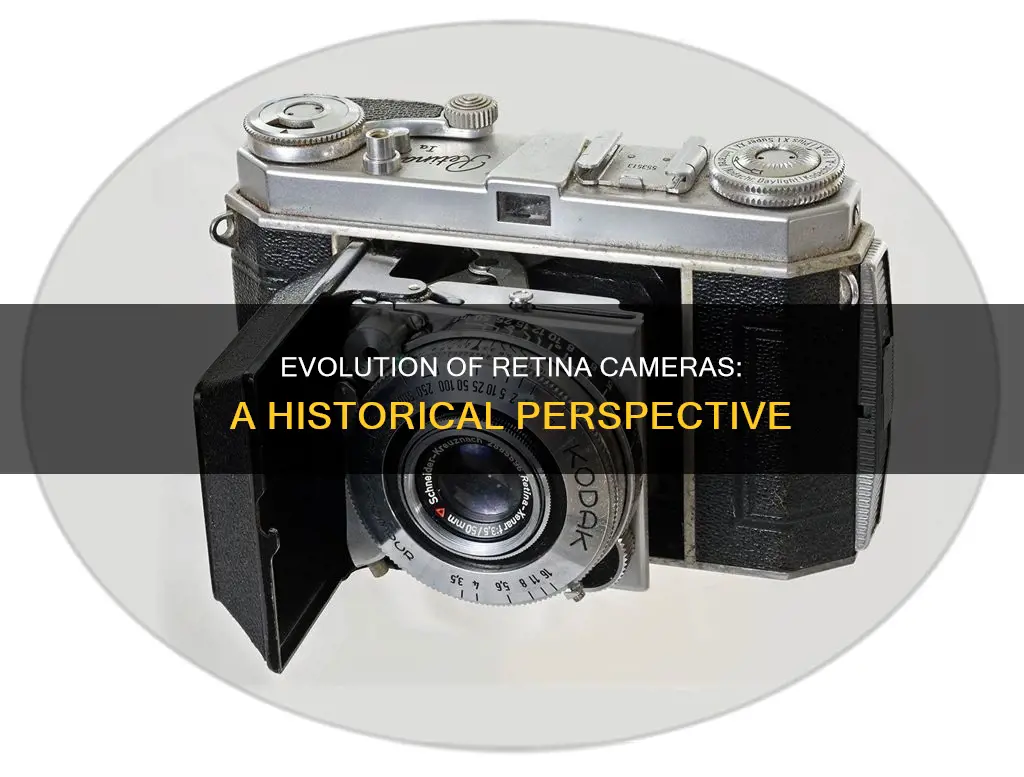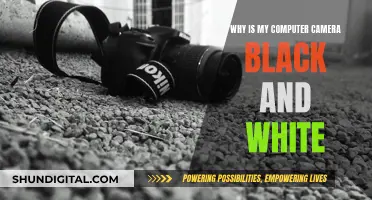
The Kodak Retina was a series of 35mm cameras produced from 1934 until 1969. The cameras were manufactured in Stuttgart-Wangen, Germany, by the Kodak AG Dr. Nagel Werk company, which Kodak had acquired in 1931. The Retina line included a variety of folding and non-folding models, including the Retina Reflex single-lens reflex camera. Retina cameras were noted for their compact size, high quality, and low cost compared to competitors.
| Characteristics | Values |
|---|---|
| Brand Name | Retina |
| Manufacturer | Kodak |
| Country of Manufacture | Germany |
| Years of Production | 1934-1969 |
| Place of Manufacture | Stuttgart-Wangen |
| Company | Kodak AG Dr. Nagel Werk |
| Founder | August Nagel |
| Type of Camera | 35mm |
| Folding and Non-folding Models | Both |
| Notable Models | Retina Reflex, Retina IIIc |
What You'll Learn

The Kodak Retina was a German-built camera
The Retina was first introduced in July 1934 by the Kodak AG Dr. Nagel Werk in Stuttgart-Wangen, Germany. The company was formed when Kodak acquired August Nagel's camera company, Dr. August Nagel – Fabrik fuer Feinmechanik Werk, in December 1931. Nagel was a prolific camera designer and entrepreneur who was one of the founders of Zeiss Ikon. He was known for his work on miniature cameras.
Kodak adopted Nagel's existing camera line-up, but new cameras were soon to come. The first Retina, known as Nr. 117, was followed by the Nr. 118 Retina in 1935, the Nr. 119 Retina (I) and the Nr. 126 Retina (I) in 1936, and the Nr. 122 Retina II in 1936. The Retina II was the first in the series to feature a rangefinder. The Retina III, which added a light meter to the rangefinder, was introduced in 1954.
The Kodak Retina was extremely popular throughout the 1950s. The Retina IIIC, the last of the folding Retinas, was produced until 1960. Gradually, Kodak pushed Nagel toward cheaper and more profitable models, often at the expense of quality and craftsmanship. Despite this, the Retina is still regarded as one of the finest cameras Kodak ever sold.
The Evolution of Camera Technology: First 1080p Camera
You may want to see also

The Retina was produced from 1934 to 1969
The Retina line included a variety of folding and non-folding models, including the Retina Reflex single-lens reflex camera. Retina cameras were noted for their compact size, high quality, and low cost compared to competitors. The Retina IIIC was the last of the folding Retinas, and the best of them all. The final models (IB, IIC and IIIC) were introduced in 1957 and the last folding Retina was made in 1960.
Kodak AG also offered a companion line of less-expensive Retinette cameras, with similar looks and function.
London Congestion Charge Cameras: Locations and How They Work
You may want to see also

The Retina was manufactured in Stuttgart-Wangen
Kodak AG Dr. Nagel Werk was the new name of the company after the merger, and it was formed in December 1931. The company was based in Stuttgart-Wangen, which was also the hometown of Dr. August Nagel.
The Retina was a long-running series of German-built Kodak 35mm cameras. The Retina line included a variety of folding and non-folding models, including the Retina Reflex single-lens reflex camera. The cameras were noted for their compact size, high quality, and low cost compared to competitors.
The Retina was manufactured in Germany, and to a smaller extent, assembled in the UK and France for the local market. This is why some models are more freely available in some countries or continents while scarce elsewhere.
The Retina was a jewel of precision. It had a great lens and a super-smooth, super-quiet leaf shutter. The lens was sharp, even in the corners and even wide open. The camera was so compact that it was much smaller than any SLR, yet maintained image quality on par with its larger brethren. The Retina was a marvel of German engineering, and its legacy lives on today.
Extending Black Magic Camera Battery Life: Top Tips
You may want to see also

The Retina was sold for around $500 to $1,000
The Retina was the brand name of a long-running series of German-built Kodak 35mm cameras, produced from 1934 until 1969. The first Retina, Nr. 117, was introduced in late July 1934 and sold for USD 52.50, which is equivalent to just under USD 1,000 in today's money. The price of the camera was cheaper than other similar cameras at the time. The Retina line included a variety of folding and non-folding models, including the Retina Reflex single-lens reflex camera.
Kodak AG also offered a companion line of less expensive Retinette cameras, with similar looks and functions. The Retina IIa Type 016, for example, was sold for $1,300, while the Canon CR-1 Mark II Fundus Non-Mydriatic Digital Retina Camera was sold for $300. The Retina cameras were noted for their compact size, high quality, and low cost compared to competitors. These cameras retain a strong following today, of both photographers and collectors.
Adjusting Your Camera for Manual Wedding Photography
You may want to see also

The Retina Reflex was introduced in 1957
The first model, the Type 025 Retina Reflex, was made in Germany between Spring 1957 and October 1958. It inherited several features from the contemporary Retina rangefinder cameras, such as the film advance and exposure counting system, the film channel, the selenium meter, and the focusing mechanics of the lenses. The Type 025 also featured a Synchro-Compur shutter, similar to earlier designs.
One of the key innovations of the Retina Reflex was its convertible lens system. The early models were equipped with interchangeable front elements and a fixed set of elements that remained on the body. Later models offered fully interchangeable lenses. This interchangeable lens system allowed for greater flexibility and convenience for photographers.
The Retina Reflex was a complex and ingenious camera, known for its heavy weight relative to its size. It was moderately successful, with approximately 65,000 units sold. The original Type 025 Retina Reflex sold for US$215 in 1958, which is equivalent to around $2,270 in 2023.
The introduction of the Retina Reflex marked a significant milestone in the evolution of the Kodak Retina camera line, offering advanced features and enhancing the user experience. It built upon the foundation laid by previous Retina models and solidified Kodak's presence in the photography market.
Checking Your Alro Camera's Battery Status: A Step-by-Step Guide
You may want to see also
Frequently asked questions
Retina cameras were made in Germany.
Retina cameras were made by Kodak.
Retina cameras were made from 1934 to 1969.
Retina cameras were 35mm cameras.
The value of a Retina camera depends on its condition and functionality. In good working condition, they can be sold for around \$50 to \$100.







